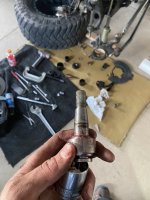Wondering what best practice would be for installing inner c gussets with dynatrac prosteer ball joints. Should I remove the whole ball joint or just pull out the inerds before welding? I'm not sure how hard the latter would be and if I could just put the pieces back without peplacing anything. Ball joints are almost brand new.
You are using an out of date browser. It may not display this or other websites correctly.
You should upgrade or use an alternative browser.
You should upgrade or use an alternative browser.
Dynatrac prosteer ball joints and welding gussets
- Thread starter Mdrobb
- Start date
WJCO
Meme King
I kept the ball joints in and just went really slow alternating side to side. I think I welded about half inch at a time. Someone hear recommended a bucket of cold water with rags to soak and then put those on the ball joints repeatedly to keep them cool while you're welding. I did that as well. Seemed to work out ok.Wondering what best practice would be for installing inner c gussets with dynatrac prosteer ball joints. Should I remove the whole ball joint or just pull out the inerds before welding? I'm not sure how hard the latter would be and if I could just put the pieces back without peplacing anything. Ball joints are almost brand new.
Cousin Clyde
Hooked
Yea I’d say WJCO is right about that. Quenching with water poses the risk of making metal brittle because it cools too fast, but it’s not significant enough to really matter in this situation if you take your time and skip around as suggested.
In the structural world for example, water quenching is illegal. Cooling with air is always ideal, but I digress.
I recently pressed out the inners of my Prosteers. It’s not hard to do, but you really have to have the thin walled 1” socket to press the heim back into the housing. I tried forcing it in with 1 1/16” socket and jacked up the machined surface inside the housing. Definitely read the instructions from dynatrac about where to set the heim on the shaft if you plan on rebuilding.
The design is pretty simple and solid. Heim pressed on shank pressed in housing pressed in knuckle.
but I digress.

In the structural world for example, water quenching is illegal. Cooling with air is always ideal, but I digress.
I recently pressed out the inners of my Prosteers. It’s not hard to do, but you really have to have the thin walled 1” socket to press the heim back into the housing. I tried forcing it in with 1 1/16” socket and jacked up the machined surface inside the housing. Definitely read the instructions from dynatrac about where to set the heim on the shaft if you plan on rebuilding.
The design is pretty simple and solid. Heim pressed on shank pressed in housing pressed in knuckle.
but I digress.

